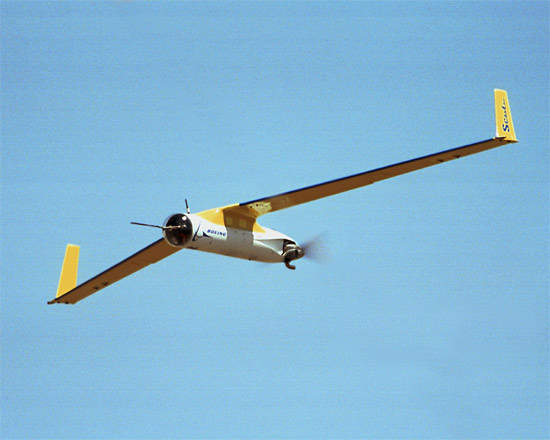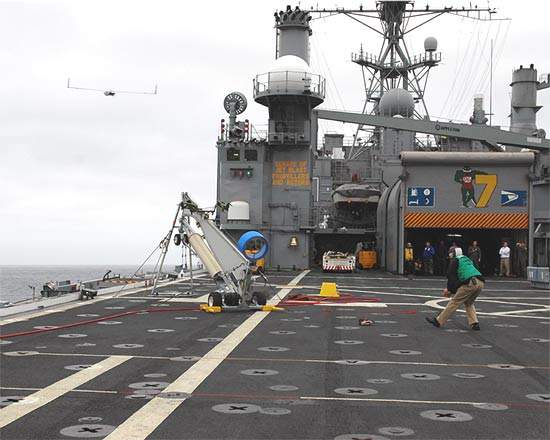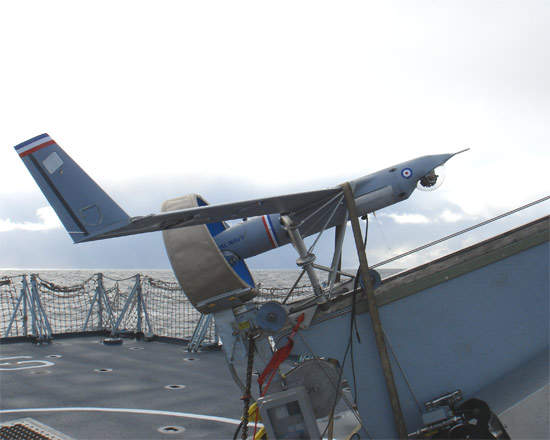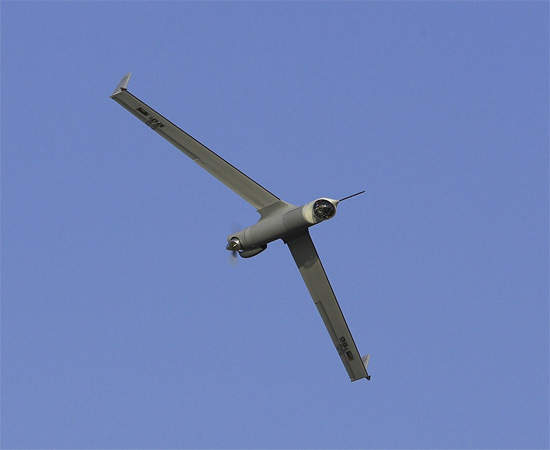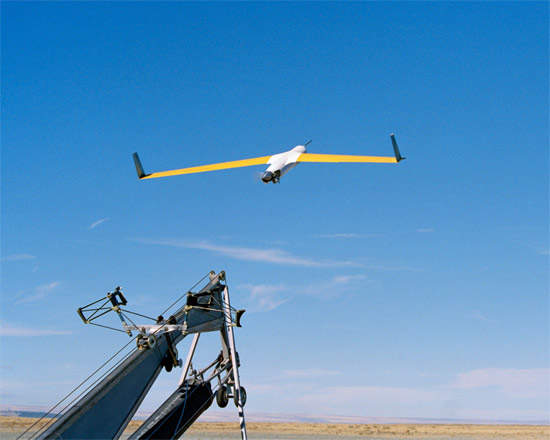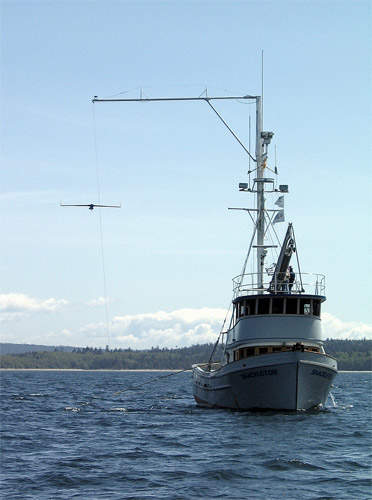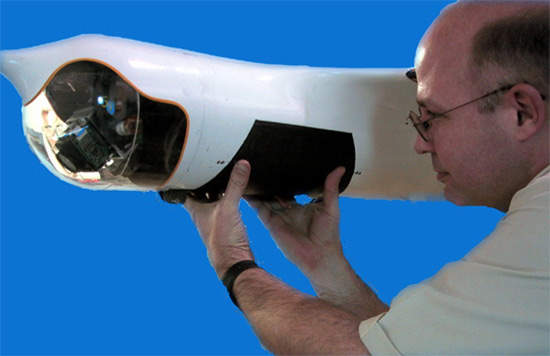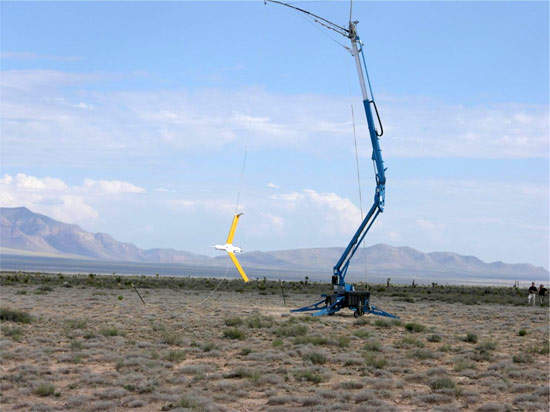ScanEagle is a mini unmanned air vehicle developed by Insitu and Boeing at the Phantom Works facility. By the end of the first quarter of 2007, it had completed over 30,000 combat operational flight hours, including operations over Iraq. The system is in operational service with the United States Marine Corps, the United States Navy and the Australian Army.
In July 2004, the USMC placed a contract for two air vehicles which were deployed to Iraq in September 2004. Under a contract placed in April 2005, US Navy ScanEagles have been deployed since July 2005 onboard 15 destroyers and LSDs. In December 2006, the Australian Army placed a contract for ScanEagle, also used in Iraq.
By January 2009, ScanEagle had made over 1,500 successful shipboard recoveries on US Navy vessels and passed 50,000 combat flight hours with the US Marines in Iraq. It has been deployed on USN amphibious assault and dock landing ships and, from 2009, the USN has plans to deploy the UAV on Ticonderoga Class Aegis cruisers.
ScanEagle has a range of 1,500km and an endurance of more than 28 hours. The air vehicle can operate at speeds between 80km/h and 126km/h and the cruise speed is 90km/h in level flight. The vehicle achieves a maximum rate of climb of 150m/min to a maximum altitude of 4,880m or 16,000ft.
ScanEagle missions
ScanEagle missions include intelligence, surveillance and reconnaissance (ISR); special services operations; escort operations; sea-lane and convoy protection; protection of high-value and secure installations; and high-speed wireless voice, video and data communications relay.
In 2000, Insitu, with headquarters in Washington, announced the development of the SeaScan UAV naval unmanned air vehicle for ship launch and recovery. SeaScan operates from naval platforms from 20ft-long patrol boats to large naval vessels. In 2002, Boeing announced a collaborative agreement with Insitu to develop the ScanEagle UAV at Phantom Works.
In 2002 the ScanEagle successfully completed its first remotely controlled flight and its first autonomously controlled flight. ScanEagle entered production at the Boeing’s Boardman aerospace manufacturing facility in Oregon.
In July 2008, Boeing announced an agreement to acquire Insitu Inc. The acquisition was completed in September 2008.
In addition to the systems in operational service, several military organisations have carried out trials with the ScanEagle including the US Marine Corps, US Navy, US Air Force, US Department of Defence, Australian Army and the UK Ministry of Defence.
UAV design
The ScanEagle air vehicle is composed of five field-replaceable major modules: nose, fuselage, avionics, wings and the propulsion system. It has a cylindrical fuselage of 200cm diameter with mid-mounted swept-back wings with winglets (wingspan – 3.1m), tail endplate fins and steering rudders.
For operation in cold environments the ScanEagle can be equipped with carburettor heating and an ice-phobic wing covering.
Turret-mounted surveillance and observation systems are mounted in the nose. The nose carries the pitot tube which is fitted with an anti-precipitation system for cold weather operation.
The air vehicle is packed into a single storage container (1.71m x 0.45m x 0.45m) for transportation to the forward area of operation.
ScanEagle launch and recovery
The air vehicle is not fitted with landing gear. On land and on naval vessels the air vehicle is catapult launched from a pneumatically operated wedge launcher with a launch velocity of 25m/s. A folded-wing variant for air launch operations from a host C-130 Hercules or V-22 Osprey has been proposed and a study was initiated in 2006.
The recovery system for ScanEagle is based on the proven SkyHook recovery system developed by Insitu, originally for the SeaScan UAV. The SkyHook retrieval system uses an arresting or snagging line suspended from a 15.2m boom. The air vehicle is flown directly to approach the snagging line and a hook installed in the air vehicle’s wingtip is caught on the line.
An alternative conventional land recovery can be used on an open area of 100ft by 600ft.
UAV payload
The payloads are housed in the nose section. The operators can swap the payloads in the field in a few minutes. The sensors installed in the turret allow the operator to track stationary or moving targets without having to re-manoeuvre the air vehicle.
The payloads include electro-optical and infrared sensors, biological and chemical sensors, laser designators and a magnetometer for identification and locating magnetic anomalies.
The nose of the ScanEagle vehicle houses a gimballed and inertially stabilised turret. An upgraded Block D variant houses a new sensor turret which accommodates larger cameras. The sensor turret can be fitted with a DRS E6000 high resolution uncooled thermal imager module providing 640 x 480 pixels with a 25 micron pitch.
In August 2008, ScanEagle was successfully flight-tested equipped with a short-wave infrared camera supplied by Goodrich Sensors.
In January 2007, the US Air Force initiated an assessment study for the deployment of a sniper gun fire detection and location system supplied by ShotSpotter Inc of Santa Clara, California. The integrated air vehicle and ShotSpotter system provides additional force protection for military convoys and military bases against sniper fire.
Other development programs are underway to examine the installation and deployment of other payloads including a lightweight high-resolution radar.
In January 2008, Boeing flight-tested the NanoSAR synthetic aperture radar (SAR) from ImSAR based in Salem, Utah. NanoSAR weighs only 2lb and claims to be the world’s smallest SAR. Also in January 2008, Boeing concluded a series of tests of the biological combat assessment system (BCAS) on board ScanEagle, as part of a demonstration for the US Defense Threat Reduction Agency (DTRA).
ScanEagle engine
The air vehicle is fitted with a pusher engine with a two-blade propeller. The piston engine develops 0.97kW. The vehicle carries a maximum of 4.3kg of fuel.
Original production models are fitted with automobile gasoline-fuelled engines. Sonex Research Inc, based in Annapolis, Maryland, was contracted to develop a converted version of the engine to operate on heavy fuel (i.e. kerosene based JP5 jet aircraft fuel).
Operation on heavy fuel achieves safety levels for naval operations and also importantly eases the logistics requirements in terms of supply, storage and availability for remote deployment.
The longest flight achieved by ScanEagle fitted with the automobile gasoline engine is 22 hours and ten minutes. The heavy fuel engine equipped ScanEagle achieved a flight endurance of 28 hours 44 minutes using JP5 fuel in an endurance flight in January 2007.
New technology including control technologies for ignition and combustion were introduced into the engine configuration in order to avoid loss of endurance by switching from gasoline to heavy fuel.
Heavy fuel engines can present problems in cold environments but the JP5 endurance flight was successfully completed in temperatures from
–16°C to –6°C.
Control and navigation
The ground control station, which can control up to eight air vehicles, is equipped with two operator consoles.
The control and navigation system provides the ScanEagle with waypoint navigation using differential GPS navigation, autonomous object tracking and autonomous in-flight route mapping. The ScanEagle is equipped with a Guidestar 111 control and navigation sensor supplied by Athena Technologies Inc, based in Virginia.
The unit, which contains solid-state gyros and accelerometers, magnetometer, GPS receiver and air data pressure transducers, provides attitude and heading measurement to high accuracy. High accuracy is maintained during dynamic manoeuvres such as sustained high-g turns through Kalman filtering and GPS magnetometer reference.
ScanEagle has a 900MHz UHF datalink and a 2.4GHz S-band downlink for video transmission.

